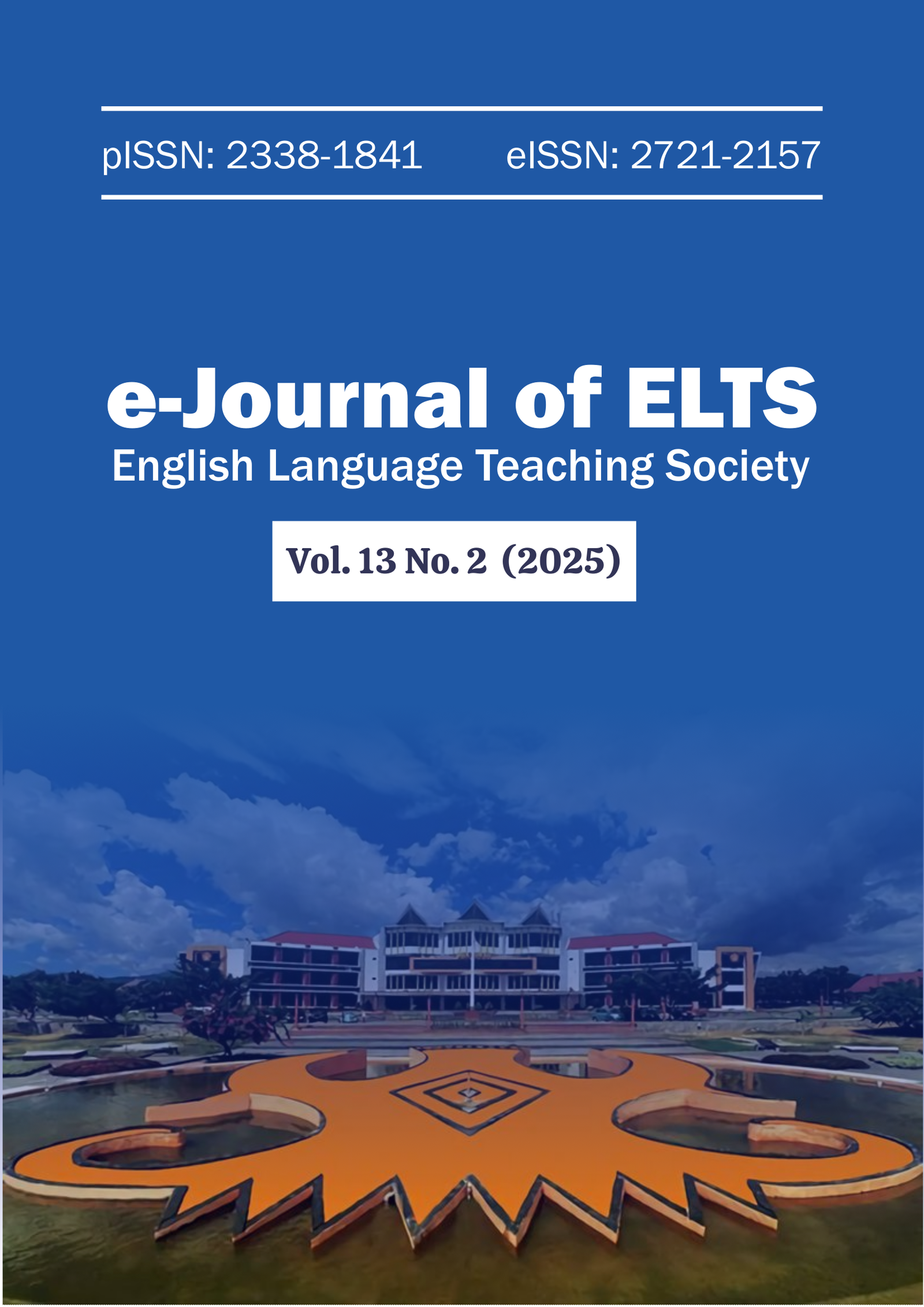IMPROVING READING COMPREHENSION OF GRADE X STUDENTS AT SMK NEGERI 1 DAMPAL SELATAN TOLITOLI THROUGH DRTA (DIRECTED READING THINKING ACTIVITY)
DOI:
https://doi.org/10.22487/elts.v13i2.4634Keywords:
Improving, Reading Comprehension, DRTA.Abstract
The objective of this research is to find out whether the use of DRTA (Directed Reading Thinking Activity) strategy can improve the reading comprehension of class X students of SMK Negeri 1 Dampal Selatan or not. This research used a pre-experimental design that involved only one class as the experimental class. The sample of this research was class X TKJ with 31 students as the experimental class selected by using purposive sampling technique. The instruments of data collection were tests, they were pretest and posttest. The experimental class was given treatment by using the DRTA (Directed Reading Thinking Activity) strategy. The data were analyzed statistically to measure the difference in score. The results shows an increase between the pretest and posttest results. The students means score before given the treatment was 51.10. After the treatment, the means score of students in the posttest was 71.48. By applying a significant level of 0.05, the researchers found that the value of t-counted (5.31) was higher than the t table (1.697). Based on these results, it can be concluded that the DRTA (Directed Reading Thinking Activity) strategy is effective to improve reading comprehension of grade X students at SMK Negeri 1 Dampal Selatan and it can be applied by teachers in teaching and learning process.
References
Alianda, R. (2022). The Implementation Of Directed Reading Thinkingactivity (Drta) Strategy In Teaching Reading Comprehension For The Viii Grade Faculty Of Tarbiyah And Teacher Training State Islamic University Of North Sumatera Medan 2022 Students Of Smp It Mutiara Deli Ser. UIN Sumatera Utara Medan.
Arista, T., Subari, I., & Marcella, E. D. (2022). Improving The Students’reading Ability Through Directed Reading Thinking Activity (Drta) Strategy At Smkn 9 Bandar Lampung. Journal of English Education Students (JEES), 4(2), 1-8.
Arikunto, S. (2010). Metode Penelitian. Jakarta: Rineka Cipta.
Arikunto, S. (2013). Prosedur Penelitian, Suatu Pendekatan Praktek. Jakarta: Bumi Aksara.
Brown, H. D., & Abeywickrama, P. (2004). Language assessment. Principles and Classroom Practices. White Plains, NY: Pearson Education.
Burns, Paul. Et al. 1984. Teaching Reading in Today’s School. Boston: Hongron Miffiki Coorperation.
Eryana S., Nappu, S., & Abdul, N. B. (2018). Enhancing Students’ Achievement And Motivation Toward Reading Comprehension By Using Humor Story (A Pre-Experimental Research at the Eleventh Grade of SMK Negeri 6 Bulukumba). JIKP (Jurnal Keguruan Dan Ilmu Pendidikan), 5(1).
Fitria, W. (2019). Reading Interest and Reading Comprehension : A Correlational Study. Reading Teacher, 4 (1). https://doi.org/10.1002/trtr.1410
Friska, Y. (2015). The effect of DRTA (Directed Reading Thinking Activity) and reading interest on students reading comprehension (an experimental study in the 8th grade students of mts jamiyyah islamiyya pondok aren. Universitas Islam Negeri Syarif Hidayatullah Jakarta.
Grellet, F. (1981). Developing reading skills: A practical guide to reading comprehension exercises. Cambridge university press.
harmer. (2017). The Effect of DRTA on Students’ Reading Comprehension for State Islamic Senior High School. Journal of English and Arabic Language Teaching, 8(2), 140–148.
Harmer, J. (2001). The practice of English language teaching. London/New York, 401-405.
Ilham, M. (2022). the Implementation of Directed Reading-Thinking Activity in Improving Students Reading Comprehension. ELITS: English Language Issues, Trends and Studies, 1(1), 18.
Nerim, N. (2020). Scrutinizing DRTA (Directed Reading Thinking activity) Strategy on Students’ Reading Comprehension. Journal of Languages and Language Teaching, 8(2), 128. https://doi.org/10.33394/jollt.v8i2.2284
Nunan, D. (2003). Practical English Language Teaching. McGraw-Hill
Richardson, J. S., Morgan, R. S., and Fleener, C. (2009). Reading to Learn in the Content Areas. USA: Wadsworth Cengage Learning.
Risdha.R. (2019). Improving Students’ Reading Comprehension Through DRTA (Directed Reading Thinking activity) Strategy At The Nineth Grade Students Of Mts Lautang Belawa.
Safitri, M., Marhaban, S., & Erdiana, N. (2022). A Review Of DRTA (Directed Reading Thinking activity) Strategy In Teaching Reading Comprehension. English Education Journal (EEJ).
Sari, L. (2017). Improving Reading Comprehension Through DRTA (Directed Reading Thinking activity) Strategy for the Eight Grade Students of SMP Negeri 17 Medan in the Academic Year of 2016-2017.
Simangunsong, N. S. (2014). Improving the Reading Comprehension of Grade VII Students of SMPN 13 Yogyakarta through the DRTA (Directed Reading Thinking activity) .
Smith, F. (1994). Understanding reading: A psycholinguistic analysis of reading and learning to read, sixth edition. Lawrence Erlbaum Associates.
Stauffer, R. G. (1969). Directing Reading Maturity as a Cognitive Process. Harper & Row.
Tankersley, K. (2003). The threads of reading: Strategies for literacy development. ASCD
Wiesendanger, Katherine D. (2001). Strategies for literacy education. Prentice Hall.
Downloads
Published
How to Cite
Issue
Section
License
Copyright (c) 2025 Nurherika Nurherika, Mawardin M. Said, Andi Patmasari, Mochtar Marhum

This work is licensed under a Creative Commons Attribution-ShareAlike 4.0 International License.
Authors who publish with e-Journal English Language Teaching Society (ELTS) agree to the following terms:
- Authors retain copyright and grant the journal right of first publication with the work simultaneously licensed under a Creative Commons Attribution License (CC BY-SA 4.0) that allows others to share the work with an acknowledgment of the work's authorship and initial publication in this journal.
- Authors are able to enter into separate, additional contractual arrangements for the non-exclusive distribution of the journal's published version of the work (e.g., post it to an institutional repository or publish it in a book), with an acknowledgment of its initial publication in this journal.
- Authors are permitted and encouraged to post their work online (e.g., in institutional repositories or on their website) prior to and during the submission process, as it can lead to productive exchanges, as well as earlier and greater citation of published work.








